Average Width Of A Car | 18 Body Types & Garage Dimensions
Few consider how the width will affect parking or whether they will be able to safely squeeze their car into the parking garage.
The average vehicle widths of cars we provide in this post are just that, average. If you are concerned about size, verify the actual length and width of the vehicle you are considering before making a purchase.
The average width of a car is around 5.4 to 9 feet, or 1645 to 2743 mm. You will need to add two feet minimum on either side, to account for opening the doors to your vehicle to exit the vehicle. A car’s actual width varies according to what kind it is.
Homeowners typically use their garages to store a variety of things, including garden equipment and their vehicles. Cars come in all shapes and sizes. However, they can be sorted into class sizes.
If you plan to park your car inside the garage, accounting for both of these items will help you decide if the width is going to be an issue.
Average Width of A Car Based On Vehicle Types
| Vehicle Type | Model Example | Width in Feet | Width in MM |
|---|---|---|---|
| Mini Car / Economy Car | Smart EQ ForTwo | 5.46 | 1663 |
| Small Sedan / Compact Car | Kia Forte | 5.84 | 1780 |
| Medium Sedan / Mid-Sized Car | Audi A4 | 6.06 | 1847 |
| Large Sedan / Full-Sized Car | Dodge Charger | 6.25 | 1905 |
| Small Station Wagon / Hatchback | Volkswagen Golf GTI | 5.90 | 1799 |
| Mid-size or Large Station Wagon | Volvo V60 | 6.07 | 1850 |
| Compact SUV / Small SUV | Honda CR-V | 6.09 | 1855 |
| Intermediate SUV / Mid-Sized SUV | Ford Explorer | 6.57 | 2004 |
| Full-size SUV/ Large SUV | Cadillac Escalade | 6.76 | 2060 |
| Sports Cars | Porsche 911 | 6.08 | 1852 |
| Sports Sedan or Sports Saloon | BMW M5 | 6.21 | 1892 |
| Supercar or Hypercar | Bugatti Chiron | 6.56 | 1998 |
| Small or Medium-size Pickup Trucks | Nissan Frontier | 5.55 | 1690 |
| Full-size Pickup Truck | Ford F-450 XL | 8.00 | 2438 |
| Passenger Vans | Ford Transit Passenger XLT Van | 6.76 | 2060 |
| Cargo Vans | Mercedes Benz Sprinter | 6.53 | 1993 |
| Minivans | Honda Odyssey | 6.54 | 1994 |
Modern car sizes vary in width a great deal depending on the make and model of the vehicle that consumers are considering. Many buyers are focused on the options, the price, and how great the car looks.
However, the car width varies by make and model. Never rely on average car model size width; always verify. Understanding car and van, SUV, and Truck widths before you make a purchase can reduce a lot of frustration later.
The following provides average widths for vehicle categories. Always verify the actual car width of the actual vehicle before finalizing your purchase.
Sedans

Sedans vary in size from mini up to full size. However, they typically come with four doors and a traditional trunk for storage and packages.
Mini Car / Economy Car
Mini cars or economy cars have an average width of 5.8 feet. Adjustment should be made for your mini cars mirrors and one or both doors being open at the same time in a garage. There is usually lots of room for storage in a single car garage with a mini. An example of a mini car is the Suzuki Alto. They are also referred to as urban cars.
Small Sedan / Compact Car
Small sedans or compact cars like the Chevy Cruze have an average width of 5 feet 10 inches in width. Mirrors and open doors should be considered before you purchase if you need to park in a small space. They can be a great city car.
Medium Sedan / Mid-Sized Car
Medium Sedans or mid-sized cars like the Honda Accord have an average width of 6 feet one inch with the doors closed and not accounting for the mirrors. They take up a little more room in a small garage, leaving less space for storage.
Large Sedan / Full-Sized Car
Large sedans and full-sized cars like the Dodge charger are on average 6 feet 2 inches wide. Add another 6 inches on either side for the mirrors and 2 to 3 feet to open the doors, and many people may not want to park their full-sized car in a single car garage. These large-size cars are often used as executive cars.
Station Wagons
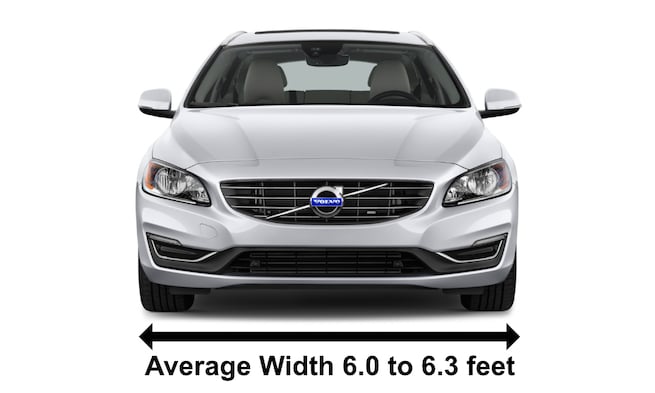
Station wagons are a blend of the sedan and the SUV. They have a hatchback instead of a trunk with the lines of a sedan. They are less popular with many people preferring SUVs.
Small Station Wagon / Hatchback
A small station wagon is often referred to as a small hatchback. The smaller wagons have less storage capacity for transporting everyday sports gear, groceries, and vacation gear. Their average width is similar to a mid-size car. Approximately 6 feet one inch, not including room for the mirrors and door opening.
Mid-size or Large Station Wagon
A mid-size or large station wagon is often referred to as a large hatchback. The larger wagons have more storage capacity for transporting everyday groceries, and vacation gear. Their average width is similar to a full-size car. Approximately 6 feet two inches, not including room for the mirrors and door opening.
Sports Utility Vehicles or SUVs
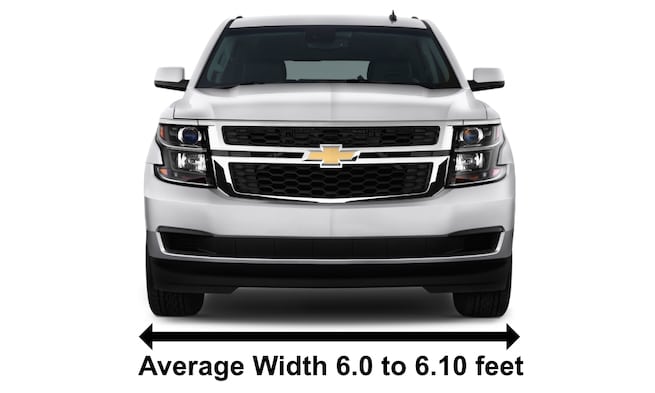
Sport utility vehicles or SUVs are taller, boxier, have better ground clearance, and a higher seating position. The cargo area is larger than a sedan and more of a hatchback design.
Compact SUV / Small SUV
Compact SUVs are sometimes referred to as compact crossover SUVs. Examples include the Honda CR-V and the Toyota RAV 4. The average width is approximately six feet, not including the mirrors or the large doors, which leaves little room for exits in smaller garages.
Intermediate SUV / Mid-Sized SUV
Intermediate SUVs or mid-sized SUV vehicles are larger and can handle more cargo. Examples include the Ford Explorer and the Honda Pilot. The average width is approximately 6 feet 5 inches, not including the mirrors or the large doors, which leaves little room for exits or external storage in smaller garages.
Full-size SUV/ Large SUV
Full-size SUV vehicles are larger and can handle large amounts of cargo. Examples include the Cadillac Escalade and the Ford Expedition. The average width of an SUV is approximately 6 feet 10 inches, not including the mirrors or the large doors. Most people will not park these vehicles in a single-car garage due to limited exit space.
Sport Performance Cars
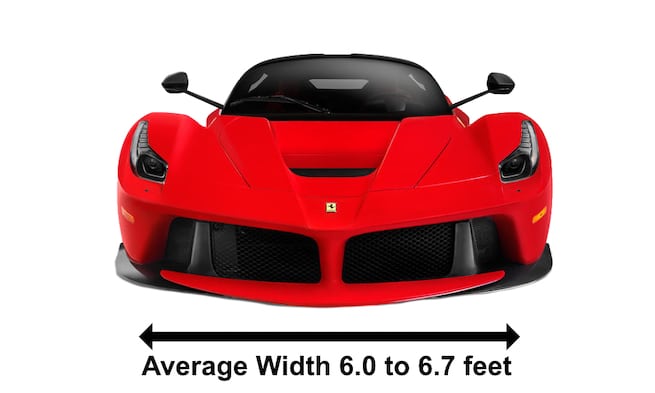
Sport high-performance cars are generally the sportiest, hottest, cool-looking, expensive, powerful, and fastest cars available. Muscle cars are often included in this category as well.
Sports cars
The term sports car includes a wide range of vehicles. Examples include the Chevrolet Corvette, the Mazda MX-5, and the Porsche 911. Average widths vary from 5.7 feet to 6.5 feet depending on the make and model of the car.
Sports sedan or sports saloon
The term sports saloon or sports sedan refers to cars that come with high performance and handling features. Examples include the Dodge charger, the BMW M5, and the Mazda 6 MPS. These cars have similar widths to full-size sedan vehicles.
Supercar or Hypercar
Supercars and hypercars are in the top 1% of vehicles on the road. The Ferrari 458 is an example of a supercar, but even this car does not match the Bugatti Chiron hypercar with 1500 horsepower. The size of these cars is immaterial since they are usually parked in a secure, environmentally controlled large garage in many cases.
Pickup Trucks
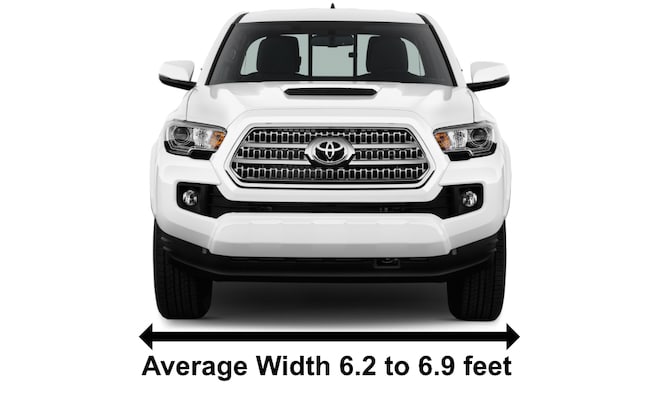
Pickup trucks come with a two-seater passenger cab, full-size seating four people, with a closed or open cargo bed that can be enclosed with a variety of add-ons. Pickup trucks are used typically as utility vehicles. However, many come with all of the latest options found in sedans.
Small or Medium-size Pickup Trucks
Small to medium-sized pickup trucks include the Ford Ranger and Nissan Frontier. The average width is 6 feet 3 inches. Pickup trucks often have side mirrors that extend up to a foot or more from the side of the truck to see past trailers that are being towed.
Full-size Truck
Full-sized pickup trucks include the GMC Sierra 1500 and the Dodge Ram 1500. The average width is 6 feet 8 inches. Pickup trucks often have large side mirrors extending a foot or more from the side of the truck to see past trailers that are being towed and eliminate blind spots.
Vans
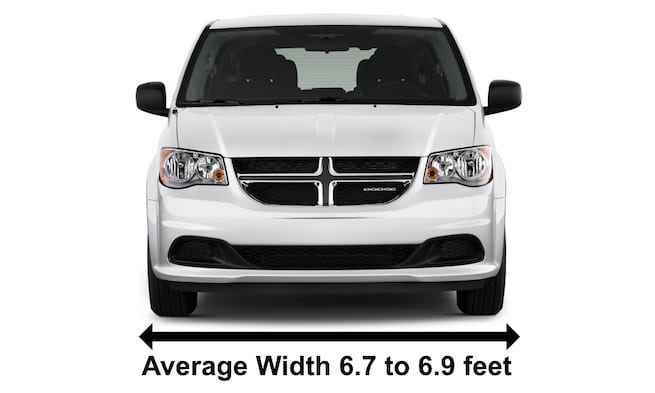
Vans come in all widths and are aimed at various markets. Some are used to transport people, e.g., school kids, while others are purely for the transportation of cargo. They vary in width, but the typical width of a minivan is 6 feet and 7 inches.
Passenger Vans
Passenger vans are equipped with several rows of seats, a row of seats that fold into the floor, or perhaps several bench seats. A large van can hold between eight and twelve people comfortably. Large families, hotel buses school buses are common users of this type of van. The average width is around 6 feet and 7.5 inches.
Cargo Vans
Cargo vans are used to transport cargo and vary in width. Many small business owners use cargo vans for delivery purposes, and tradespeople use cargo vans for housing all of their equipment.
They are very versatile and configurable for many different uses. Typical widths with the mirrors unfolded are 80 inches or 6 feet 8 inches.
Minivans
Minivans have become very popular with families. They are versatile, have space in the back for transporting everything from groceries to sports equipment. The seats in the back fold down to make more room, and they can carry up to eight people comfortably. Typical average widths are 6 feet 10 inches.
How To Find The Exact Width And Length of Your Car
There are several methods to use to find the exact width for a car that you may be considering purchasing. Remember to add at least 2 feet on all four sides to accommodate opening doors on either side.
Find the exact car width with a VIN decoder
Vin decoder tools are available for purchase. Insert the VIN into the tool to obtain the vehicle specifications.
Typical information provided includes Basic data, engines, transmission, standard specs, optional specs, generic equipment-optional and standard, colors interior and outside, and safety equipment. The vehicle width is included in the standard specification section.
Your local dealer can provide the width and length of the car
If you plan to purchase a vehicle from a dealer and have some concerns about the width of the vehicle, the dealer can provide this information. New car specification sheets include this information, and the manual for a used car also contains all of the specifications, including the width of the vehicle with the doors closed.
Measure your car’s dimensions manually
One of the easiest ways to find the car dimensions is to measure the car manually. Simply use a tape measure and stand at the driver’s side door. Run the tape under the car and position it to measure the width of the car. Pay attention to how far the side mirrors extend out. If space is tight, you want to include the width to the outside of the mirrors.
Use a car valuation website and search your vehicle type
Car valuation websites are another great way to obtain information about the value of specific vehicles based on age, mileage, and options.
Some sites may provide specific details about specifications and options on particular models. Always check the width of the actual vehicle you are purchasing for any aftermarket changes.
What are the minimum dimensions for parking spaces?
Parking space guidelines vary a great deal depending on the municipality guidelines, parallel parking to the road, perpendicular parking to the road, commercial parking lots, mall parking, and private parking spaces.
The minimum width of parking spaces ranges from 8.5 to 9.0 feet and 16 to 20 feet deep, although some retailers are offering larger spaces to accommodate larger cars and space to open doors.
Garage Size According To The Average Car Lengths And Widths Range
Size really does matter when considering the size of a garage, and the garage door, whether you are building a new one or considering purchasing a home with one.
Car size, storage space needed, and enough room to open the car doors should be considered. Moreover, the architect must take into account the width and length of an SUV or midsize truck when designing the garage.
One car garage dimensions
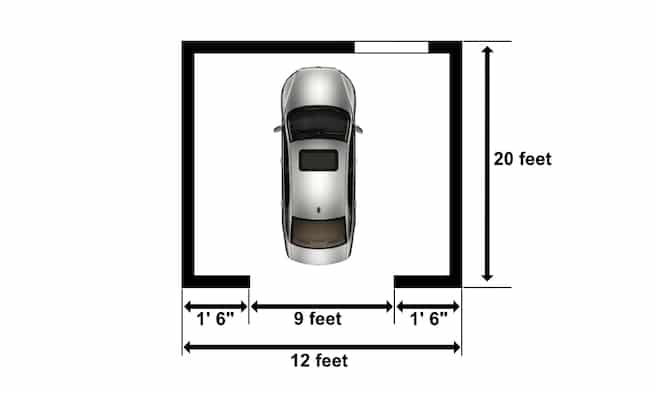
Common but conservative single-car garages are typically 12 feet by 20 feet. Most vehicles are an average of 6 feet wide, leaving 3 feet on either side to open the doors.
Three feet is just enough to be comfortable entering and exiting the car. There is little room for storage unless you have a compact car that is 6 feet wide and only 15 feet long.
Two car garage dimensions
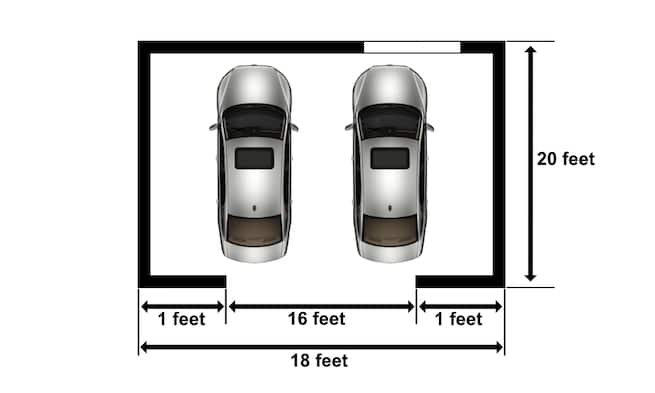
The average two-car garage is 22 feet wide and 20 feet long. Parking two cars in a garage takes 12 feet, and you need three feet on either side and two feet between them. Again little room for storage, especially if you have larger vehicles such as an SUV or truck.
Three car garage dimensions
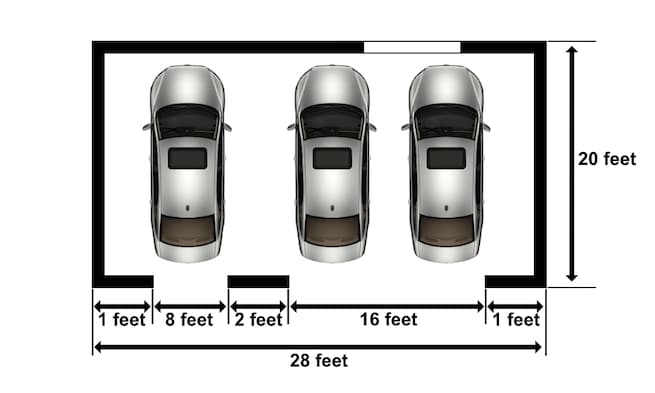
Common widths for a three-car garage are 31 to 34 feet, and the depth of the garage may vary from 20 feet to 24 feet. There may be three regular-sized doors or one regular size door, and one double-wide door. Three cars take 3 times 6 feet or 18 feet with a little more than 2 feet between cars for open doors.
Four car garage dimensions
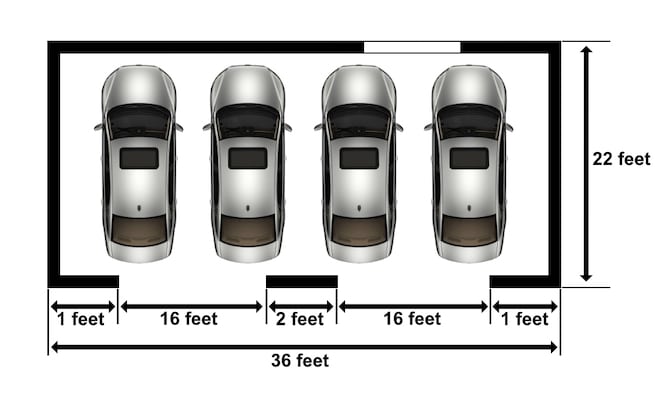
Four car garages are rare. Typical dimensions are 40 feet wide and 20 feet in depth. There are usually two double-wide doors. Most consumers will have a variety of cars, some at full width and others that are more compact.
Unless all four cars are full size, this garage can easily accommodate four vehicles. Most architects understand the average lengths of cars varies, so they take this into account for the car dimensions.
How wide is a small car in feet?
The majority of cars are six feet wide, not including mirrors or open doors. Compact cars or small cars can be slightly smaller at 5 feet ten inches. Typical cars in this category would include the Kia Rio, Chevy Cruz, the Ford Focus, and the Mazda 3.
What is the average width of a family car in meters?
Family cars which include sedans, SUV’s and vans, are typically 6 feet and one inch or approximately 1.9 meters to 6 feet and 10 inches or 2.1 meters in width, not including the side mirrors or open doors. Compact cars are approximately 1.8 m in width.
What is the average car width with doors open?
Smaller cars have smaller doors unless they are 2 door hatchbacks. Larger cars, SUV’s and trucks have longer doors and tend to open wider. Experts suggest that homeowners should allow for an extra 5 or 6 feet to allow for both doors to be open at the same time.
Summary
Car owners can avoid surprises after bringing a new car home by measuring their new vehicle and assessing whether they will be able to park it in the garage along with all of the tools etc.
Insurance companies sometimes charge a higher premium for vehicles not parked inside in a protected space. We recommend checking the average weight, width, and car length according to the manufacturer.
Last Updated on: August 23, 2022

